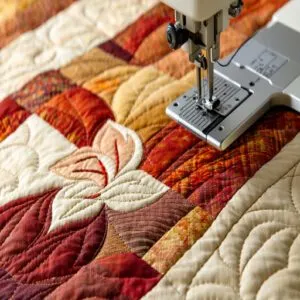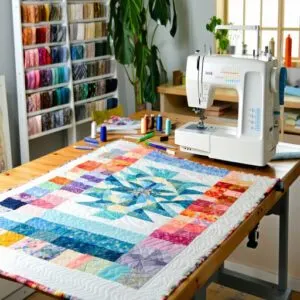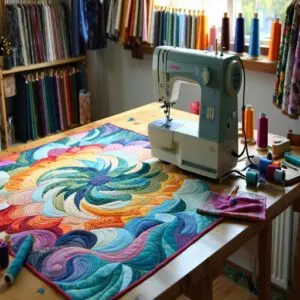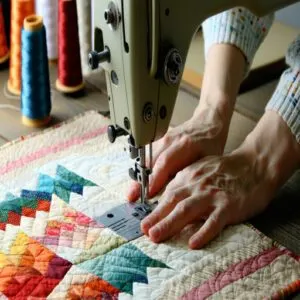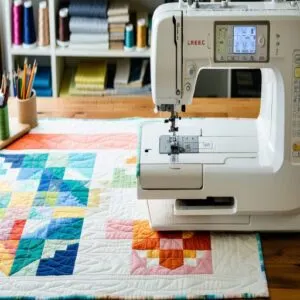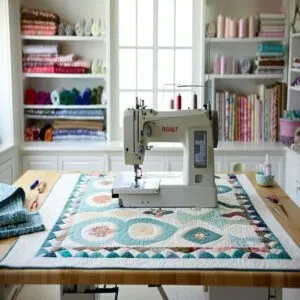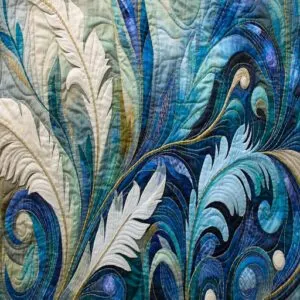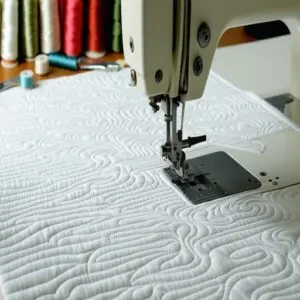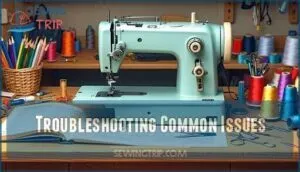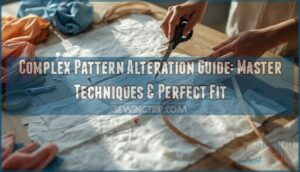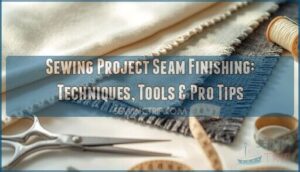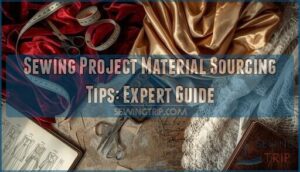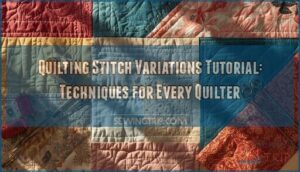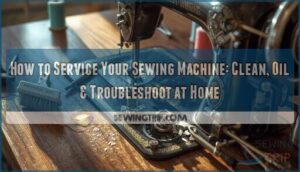This site is supported by our readers. We may earn a commission, at no cost to you, if you purchase through links.
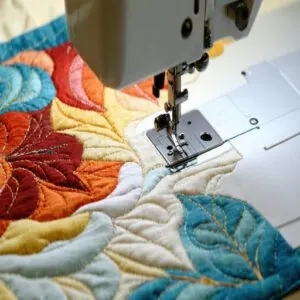
Templates are fantastic for precise patterns like geometric designs, while freehand quilting lets your imagination flow freely—think of it as doodling on fabric.
Continuous line quilting connects motifs seamlessly, adding a professional touch.
Drop those feed dogs for unrestricted movement, and adjust your stitch tension for smooth, even lines.
Combine sharp needles and quality threads for flawless stitches that don’t skip or snap.
Experimenting with tools and techniques can feel like discovering a new superpower.
Curious about feathers, swirls, or advanced stippling? There’s much more to explore!
Table Of Contents
Key Takeaways
- You’ll need to lower your feed dogs and use a darning foot or hopping foot to achieve unrestricted fabric movement, letting you guide your quilt in any direction for intricate designs.
- You must maintain consistent thread tension and stitch length settings, while using sharp needles matched to your thread weight to prevent skipped stitches and breakage.
- You’ll master control by practicing basic patterns like loops and pebbles before advancing to more complex designs like feathers and swirls, focusing on smooth, continuous movements.
- You can prevent fabric drag and bunching by using a silicone slider mat, keeping proper tension, and maintaining steady speed with your foot pedal while guiding the fabric.
Free Motion Quilting Basics
To master free motion quilting, you’ll need the right tools, quality fabrics, and a good understanding of machine settings.
Start with the basics to build a strong foundation, and you’ll be on your way to creating stunning, customized quilt designs.
Essential Quilting Tools
To conquer free motion quilting, start with sharp quilting needles and a reliable sewing machine.
A darning foot (or quilting foot) offers the control you need for intricate designs.
Rotary fabric cutters, quilting hoops, and quality thread conditioners make stitching smoother.
Pair these tools with confidence, and watch your quilting foot control transform basic fabrics into striking creations.
Investing in the right quilting sewing machines can substantially enhance your overall quilting experience.
Quilting Fabric Selection
Choosing the right fabric sets the stage for smooth free motion quilting.
Go for fabrics that are easy to manipulate and complement your quilting foot.
When selecting fabrics, consider the quality of cotton quilting fabric to guarantee the best results.
- 100% cotton fabrics: Tight weave and consistent thread counts handle stitching beautifully.
- Test fabrics: Feel the weave types; avoid anything too slippery.
- Color theory: Dark or light shades affect design visibility, so plan ahead!
Thread Types and Colors
Thread choice can transform your quilting.
Experiment with thread weights, fiber blends, and dye effects to nail the perfect look.
Use color theory to harmonize or contrast designs, and explore texture contrast for depth.
Keep thread tension control in check, especially with thread art like painting or sketching.
Understanding thread color matching is essential for achieving the desired appearance.
Here, quick comparisons make decisions easier:
| Thread Type | Best For | Texture | Durability | Dye Consistency |
|---|---|---|---|---|
| Cotton | Smooth finishes | Matte | High | Even |
| Polyester | Varied designs | Slight sheen | Very High | Vibrant |
| Rayon | Decorative flair | Glossy | Medium | Bold |
| Wool | Unique accents | Fuzzy | Medium | Slightly uneven |
| Metallic | Standout effects | Shiny | High | Tricky to manage |
Advanced Quilting Foot Techniques
You’ve mastered the basics, so now it’s time to explore advanced quilting foot techniques that bring your designs to life.
Learn how tools like templates, freehand skills, and continuous line methods can create intricate, professional-quality results with ease.
Free Motion Quilting Templates
Quilting templates simplify free motion stitching, turning tricky designs into fun possibilities.
Want precision? Templates help you nail shapes no sweat.
Grab these essentials:
- Template materials, like acrylic or tear-away stencils, for reliability.
- Fabric guides to keep quilt embellishments straight.
- Use quilting stencils for intricate design patterns on your quilt top.
For advanced quilting, explore quilting templates to enhance your skills.
Templates are your shortcut to customized quilt magic!
Custom Freehand Quilting
Custom freehand quilting lets you embrace creative freedom by ditching templates and drawing your own path.
Sketch quilting designs first—on paper or directly on fabric—with confidence, and practice free motion stitching on scraps to master fabric control and stitch variations.
To achieve professional results, understanding free motion quilting is essential for any quilter, and experimenting with quilting styles, like flowing lines or bold swirls, can help develop unique freehand designs using advanced foot techniques.
Continuous Line Quilting
Continuous line quilting is all about keeping your stitch flow smooth and uninterrupted, like drawing without lifting your pen.
It challenges your fabric movement and line control, demanding total focus and rhythm.
With advanced foot techniques, you’ll master stunning quilting patterns while improving design precision.
Think of it as stippling with purpose—one continuous masterpiece stitched into life.
Mastering machine quilting techniques is essential to achieve professional-looking results in continuous line quilting.
Quilting Machine Settings
Getting your quilting machine settings just right can make or break your free motion quilting experience.
From adjusting stitch length and tension to lowering the feed dogs and picking the perfect needle, each step guarantees smooth, precise stitching that brings your designs to life, which is crucial for a good quilting experience.
Adjusting Stitch Length and Tension
Mastering stitch control and tension adjustment is key for free motion quilting.
Set stitch length to zero and dial down thread tension to prevent puckering.
Find your rhythm with consistent speed settings and steady fabric handling.
Remember:
- Adjust stitch length to zero.
- Keep tension in a low range.
- Regulate speed.
- Maintain smooth fabric motion.
- Test on scraps first.
This process requires patience and practice to achieve free motion quilting with ease, and it’s crucial to maintain smooth fabric motion to ensure professional-looking results.
Lowering Feed Dogs for Control
Lowering the feed dogs releases your creative control by letting you guide the fabric freely under the quilting foot.
Think of it like steering without autopilot—you’re in charge!
Adjust them via your machine’s settings for smooth fabric movement.
Here’s a quick comparison:
| Setting | Impact | Pro Tip |
|---|---|---|
| Lower Feed Dogs | Full Fabric Control | Pair with darning foot |
| Default Position | Guided Movement | Great for straight seams |
| Stitch Regulation | Manual | Manage quilting speed |
This setting allows for full fabric control, enabling you to maneuver the fabric as needed, and with the darning foot, you can achieve more intricate designs.
Choosing The Right Needle
When perfecting free motion quilting, your needle choice makes all the difference.
Improper selection leads to skipped stitches or thread havoc.
Here’s how to guarantee stitch quality and thread management:
- Use sharp needles for smooth fabric penetration.
- Match needle size selection to thread weight.
- Opt for specific quilting needle types.
- Regularly swap needles to prevent breakage.
Using the right sharp quilting needles is vital for achieving professional results in free motion quilting projects.
Mastering Free Motion Designs
You’ve got the tools, now it’s time to focus on mastering the art of free motion designs to elevate your quilting projects.
From loops and pebbles to feathers and swirls, these advanced techniques will help you create stunning, professional-quality patterns with ease.
Loops and Pebbles Techniques
Loops and pebbles are go-to quilting motifs that add charm and flow to any project.
For loop patterns, relax your hands and let the fabric glide naturally, creating soft, continuous shapes.
Pebble designs, resembling stacked circles, demand steady stitch control.
A free motion stitching guide can help you select the right tools and techniques.
Perfecting these free motion quilting techniques takes practice, but mastering fabric manipulation opens up endless possibilities for creative meander and stipple combinations.
Feathers and Swirls Patterns
Looping smoothly from pebbles to curves, feathers and swirls facilitate dynamic movement in free motion quilting.
Feather motifs add elegance to any project.
Here’s how:
- Stitch a wavy spine to anchor feather swirls.
- Alternate curves outward for symmetry.
- Echo edges for depth.
- Try open swirl designs for flexibility.
- Contrast patterns with tight stippling or soft meandering.
The steps above outline a basic approach to incorporating feather motifs into your quilting projects.
Advanced Stippling Methods
Over time, your stippling patterns can go from basic meandering to advanced micro stipple techniques that create stunning background textures.
Play with stipple fills using dense stitching for intricate designs.
Practice controlling your quilting foot to master smooth loopdeloops without sharp angles.
With free motion quilting, the key is steady speed and rhythm.
Relax—it’s stitching, not rocket science!
Troubleshooting Common Issues
When free motion quilting doesn’t go as planned, small issues like skipped stitches, fabric bunching, or uneven tension can quickly become frustrating.
Don’t worry—most problems have simple fixes, and with a little troubleshooting, you’ll be back to smooth stitching in no time.
Fixing Skipped Stitches and Tension
Skipped stitches and tension issues can turn quilting into a headache.
Master stitch control with tweaks like adjusting thread tension and trying needle calibration.
Avoid feeding frustration by solving free motion quilting hiccups:
- Replace the needle or switch needle type.
- Adjust top thread tension.
- Keep feed dogs up.
- Check bobbin placement.
- Confirm proper quilting foot attachment.
Skip stress, not stitches!
Preventing Fabric Drag and Bunching
Nobody wants wrinkles or jerky stitches when free motion quilting.
To keep things smooth, steady your fabric manipulation.
Use a quilting foot, adjust thread tension, and drop feed dogs for ultimate fabric control.
A silicone slider mat works wonders for drag reduction.
Need guidelines?
Check this quick table for tips:
| Problem | Fix | Tools Needed | Skill Focus |
|---|---|---|---|
| Fabric slippage | Increase tension slightly | Quilting foot | Fabric control |
| Drag and bunching | Use a silicone slider mat | Slider mat | Smooth movement |
| Uneven stitches | Slow down and practice stippling | Sewing machine | Speed consistency |
| Poor flow | Adjust needle position/tension | Adjustable needle | Fabric manipulation |
This information should help you improve your quilting skills by addressing common issues such as fabric slippage, drag and bunching, uneven stitches, and poor flow.
By following these tips and using the right tools, you can achieve professional-looking results with your free motion quilting projects.
Maintaining Machine and Tool Quality
Keep your sewing running smoothly with these quick tips:
- Sewing Machine Cleaning: Dust builds up fast—clean out those nooks regularly!
- Machine Oil Change: Feed your machine that oil it craves.
- Needle Replacement: A dull needle messes everything up—switch often.
- Tool Sharpening & Quilting Foot Maintenance: Keep tools sharp and the darning foot pristine for seamless free motion quilting.
For a thorough guide, review a sewing machine maintenance checklist.
Frequently Asked Questions (FAQs)
What are advanced techniques for free motion quilting?
Picture stitching elegant designs without lifting your needle—advanced free motion quilting includes thread painting for bold texture, custom freehand quilting for uniqueness, trapunto for depth, and continuous line quilting for seamless, flowing artistry.
This form of quilting allows for limitless creativity and various techniques to be applied, enabling quilters to explore different styles and designs.
What is free motion quilting?
You’ll create beautiful, flowing designs by moving fabric freely under your machine’s needle while the feed dogs are down.
It’s like drawing with thread – your hands guide the movement to stitch stunning patterns.
Do you need a foot for free motion quilting?
A recent study shows 8% of quilters embraced free motion techniques in
You’ll definitely need a special darning or hopping foot – it’s required to move fabric freely while keeping layers smooth.
What foot do you use for free-motion quilting?
You’ll need a darning foot or hopping foot for free-motion quilting.
These specialized feet lift up and down as you stitch, letting you move fabric freely in any direction when creating designs.
How do you use a quilting foot on a sewing machine?
Studies show 30% of quilters start with basic foot techniques.
First, drop your feed dogs, attach the foot firmly, and adjust your tension.
Then, guide your fabric smoothly while controlling speed with your foot pedal.
What is the best foot for free motion quilting?
You’ll want a darning foot or hopping foot for best control.
They’re spring-loaded to bounce up and down, letting your fabric move freely while keeping consistent tension.
A ruler foot works great too.
Why does my thread keep breaking when I am free motion quilting?
Your thread’s probably breaking due to incorrect tension settings. You’ll want to check your needle size, thread quality, and make sure you’ve threaded correctly. Clean your machine’s tension discs too.
What setting should I use for free motion quilting?
Set your stitch length to zero, lower the feed dogs, and adjust tension to medium-high.
You’ll need a medium-fast speed with balanced top and bobbin tension.
Don’t forget to test on scraps first.
How to get even stitches when free motion quilting?
Practice makes perfect!
To achieve even stitches, maintain steady speed, move your hands smoothly, and keep your fabric taut.
You’ll need consistent tension settings and regular practice on scrap fabric before tackling projects.
How to create precise echo quilting designs?
Start by outlining shapes with your needle’s tip at a consistent distance from the original design.
You’ll maintain even spacing by following the first line’s curves as your guide for subsequent layers, which involves keeping a consistent distance.
Conclusion
Who knew that mastering advanced free motion quilting foot techniques could transform your fabric into a canvas of endless possibilities?
You’ve learned the essentials: dropping those feed dogs, maintaining proper tension, and selecting the right tools.
Remember, practice makes progress – not perfection.
Whether you’re creating intricate feathers or flowing stipples, your unique style will shine through.
Keep experimenting, stay patient with yourself, and watch your quilting confidence soar to new heights.
- https://www.gathered.how/sewing-and-quilting/quilting/how-to-quilt/free-motion-quilting-foot
- https://teamsewing.com/free-motion-quilting-foot/
- https://www.stringandstory.com/blog/fmqfeet
- https://weallsew.com/how-to-get-started-with-free-motion-quilting/
- https://www.xometry.com/resources/sheet/what-is-mylar/

